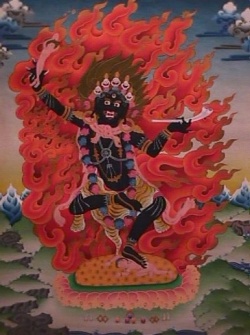Lang Darma
Langdarma (also Glang-dar-ma, Glang dar ma), regal title Tri Uidumtsaen (Khri 'U'i dum brtsan) was the last emperor of the unified Tibetan empire, who most likely reigned from 838 to 841 CE. Early sources named him Tri Darma meaning "King Darma"; "Lang" is a nickname meaning "ox". He was also called tsenpo (emperor) or lhase (divine son) U Dumten ('U'i dum brtan). His domain extended beyond Tibet to include Dunhuang and neighboring Chinese regions.[
By tradition Langdarma is held to have been anti-Buddhist and a follower of the Bön religion. He is attributed with the assassination of his brother, King Ralpacan, in 838 CE and he is generally held to have persecuted Buddhists in Tibet. The anti-Buddhist portrayal of this King has been questioned by several historians,[ most prominently Yamaguchi Zuiho.
During the first two years of his rule, he remained a Buddhist, but with the influence of Be Gyaltore (Tibetan: དབས་རྒྱལ་ཏོ་རེ།), he became a Bon follower.
Langdarma's reign was plagued by external troubles. The Uyghur state to the north collapsed under pressure from the Kyrgyz in year 840, and many displaced people fled to Tibet.
According to one source he only reigned for a year and a half, while others give six or thirteen years. Langdarma himself was assassinated, apparently by a Buddhist hermit or monk named Lhalung Pelgyi Dorje of Lhalung, in 842 or 846.[ His death was followed by civil war and the dissolution of the Tibetan empire, leading to the Era of Fragmentation.
Langdarma is said to have had two sons, Yumten, by his first wife, and Ösung by his second wife. They apparently competed for power, the former ruling over the central kingdom of Ü, and the other ruling over the 'left wing' - probably the eastern territories.
One of Langdarma's grandsons, Skyid lde nyima gon (or Nyima gon) conquered Western Tibet in the late 10th century, although his army originally numbered only 300 men. Several towns and castles are said to have been founded by Nyima gon and apparently ordered the construction of the main sculptures at Shey. "In an inscription he says he had them made for the religious benefit of the Tsanpo (the dynastical name of his father and ancestors), and of all the people of Ngaris (Western Tibet). This shows that already in this generation Langdarma's opposition to Buddhism had disappeared." Shey, just 15 km east of modern Leh, was the ancient seat of the Ladakhi kings.
